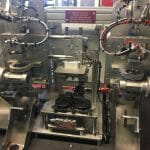By Karl Lycett, Rittal’s Product Manager for Climate Control
Food processing is a sector that demands very high standards of efficiency to meet daily production throughput targets. Any unexpected breakdown of critical components which stops production lines can have a major impact, not just in terms of loss of output, but also unplanned maintenance.
Electrical componentry is protected by an enclosure which is designed to protect the equipment from the ambient environment and create a secure atmosphere in which the climate is maintained within the required parameters.
As the temperature rises due to the summer months or random heat waves throughout the year, these parameters can be breached. In turn, the overall life of the componentry within the enclosures can reduce and the probability of an unexpected system failure increases drastically.
Care needs to be taken when implementing climate control equipment to ensure it is suitable to handle the rigours of the environment in which it is situated.
Below are some key aspects to consider when reviewing your climate control solutions.
Is your solution right for the environment?
The type of product being processed on-site and/or the location of the equipment within the facility are likely to heavily influence your climate control solution.
- If the ambient temperature of your facility remains lower, year-round, than the desired enclosure internal enclosure temperature then fan-and-filter units and air-to-air heat exchangers can be very effective. They use the ambient air to remove heat energy from the enclosure, releasing it back into the environment.
If the ambient temperature rises above the desired internal temperature then units with active cooling circuits must be used. Wall/roof-mounted cooling units and air-to-water heat exchangers include a refrigerant to remove the excess heat from enclosures and maintain the desired conditions.
Already in 2018 we have seen unexpected jumps in average temperatures across the country, and this will only increase as we move into the summer months. These jumps, as I’ve indicated, are what put cooling equipment under the most strain, therefore reviewing existing equipment sooner rather than later can reduce the likelihood of unexpected breakdowns.
- Dusty or acidic contamination (e.g. flour or yeast/vinegar extracts) can interfere with switchgear and cause short circuits or a reduction in service life.
Applying filter mats to fan and filter units will help, but if the environment is extremely contaminated you might be better off installing a cooling unit to ensure that the internal and external air-paths are exclusive thus ensuring contaminated air isn’t drawn into the enclosure.
Cleaning/Maintenance Regime
Establishing a regular inspection and cleaning of cooling equipment is very good practice. For example, vacuum cleaning units with filter mats to remove any dust and debris which might choke the fan. The will mean the unit works harder for longer and also reduces its cooling capacity.
Cooling units must also be kept clean to maintain the highest standards of hygiene. Some will be cleaned daily with pressure washers and jet steam cleaners in which case use units which meet the required ingress protection rating desired for your site and purchase additional cowls or covers as needed.
Increasing Energy Efficiency = Reduced Costs
Many food production facilities work around the clock and with energy prices rising globally, it’s vital to get early warning of any potential issue which could impact on productivity or costs.
For example, unlike speed-controlled cooling devices, such as the new Rittal Blue e+ cooling units, conventional units start when the temperature inside the enclosure gets above set point (normally 35°C) and finish when the shutdown temperature of 30°C is achieved (at a typical hysteresis of 5K). If the device does not reach the shutdown temperature it will continue to operate at full output, using large amounts of energy. This is one good indicator that the unit is inadequate for the job and that too little cooling air may be getting to electrical components.
The best course of action in all instances is to undertake a survey of your existing cooling equipment utilising the points above.
Rittal is happy to offer you a free RiAssure Cooling Inspection in which one of our trained representatives visits your site to provide you with honest, clear advice on your existing equipment and its suitability within the chosen environment/process.
We will then provide you with a short report which includes feedback on the next best steps forward for your installation, whether it is implementing a maintenance contract to prolong the life of existing equipment or the replacement of units that are undersized to improve performance and increase the energy efficiency of your site.
For more information, go to www.rittal.co.uk or email Karl at klycett@rittal.com.






